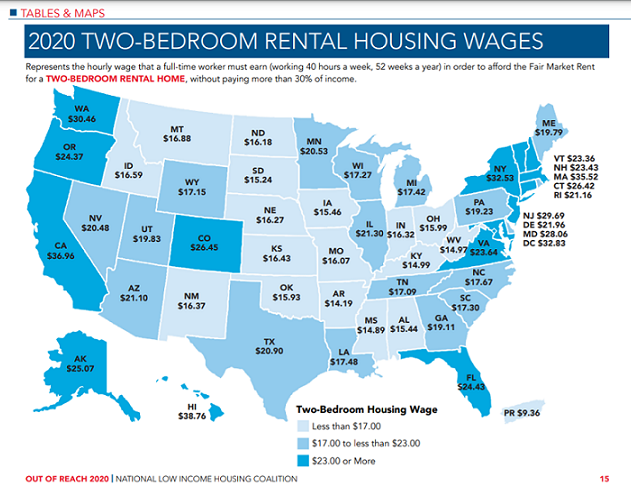It’s no secret that minimum wage in the United States is not very much money. A report done last summer showed that the income needed to afford rent in every single state is more than double the minimum wage. This proves just how unaffordable the United States is.
The Income Needed To Afford Rent In America Is Much Higher Than Minimum Wage
The income needed to afford rent in the United States – or at least, to keep rent under the recommended 30% of your income – is out of reach for many Americans. The reality is if you make minimum wage in this country, your ability to rent an apartment is shockingly low. On top of this, additional expenses like phone and internet, food, transportation, and other home bills are pushing minimum wage workers under the poverty line. (1)
The National Low Income Housing Coalition’s Out Of Reach report for 2023 showed income needed to afford the rent for a modest two-bedroom is more than double the federal minimum wage. For reference, that wage is $7.25. This is a fact for every single state except for Puerto Rico.

The lowest minimum wage income required to afford rent was in Arkansas at $14.19 per hour. The state-required minimum wage there is $10. The highest was found in Hawaii at $38.76 per hour. Hawaiin minimum hourly wage still remains at just $10. All of this means that the average American needs to work 97-hour weeks 52 weeks of the year in order to afford rent.
What Has Caused The Disparity?
The average hourly wage required to rent a home without being one emergency away from eviction in America is $23.96 per hour for a modest two-bedroom home and $19.56 for a one-bedroom. Instead, renters are spending over half of their income on housing that is poor quality and unsafe, whether because of the conditions of the home or the neighborhood that it is in.
So how did we get here? Well, experts say that there are a few reasons, primarily:
- Poor political decisions
- Systemic racism and inequality
On top of this, the pandemic has exacerbated this issue even further, with millions of Americans out of work either temporarily or permanently.
“Housing is a basic human need, but millions of people in America cannot afford a safe, stable home,” stated NLIHC President and CEO Diane Yentel in a press release. “The harm of this enduring challenge is laid bare during the COVID-19 pandemic, when millions of people in America risk losing their homes. The lack of affordable homes for the lowest-income people is one of our country’s most urgent and solvable challenges, during and after COVID-19; we lack only the political will to fund the solutions at the scale necessary. It’s time for Congress to act.” (2)
What Can Be Done?
This is another very complicated question that doesn’t really have a straightforward answer. During the pandemic, the NLIHC urged the government to release $100 billion in emergency rental relief. They also called for a moratorium on evictions and foreclosures. They also pushed for more protection for those experiencing homelessness and more funding for shelters and other similar housing resources.
Of course, these are just temporary solutions. The NLIHC says that the government must make a profound commitment to the National Housing Trustfund and Housing First vouchers. These actions could actually make housing affordable in America in the long term.
Keep Reading: Single Mom Facing Homelessness Built A $10K Tiny Home Instead Of Taking Out A $300K Mortgage
Sources
- ” Out of Reach: The High Cost of Housing.” Reports.
- “New Report from National Low Income Housing Coalition: “Out of Reach” Rents in Context of COVID-19.” NLIHC.

